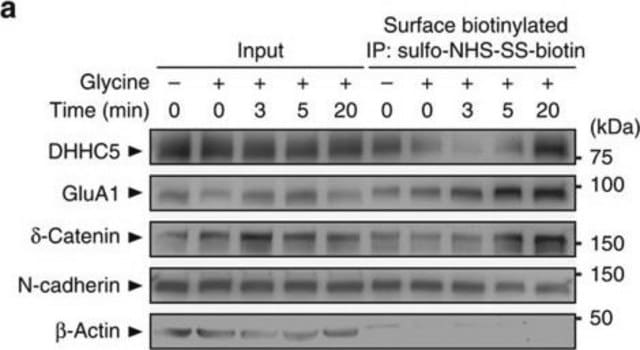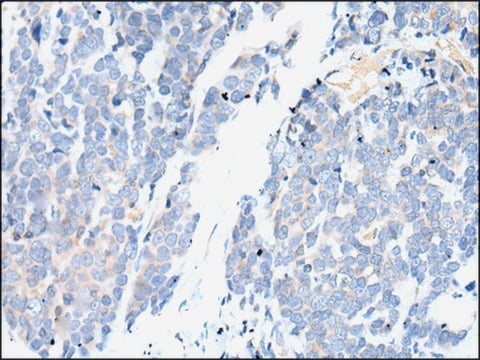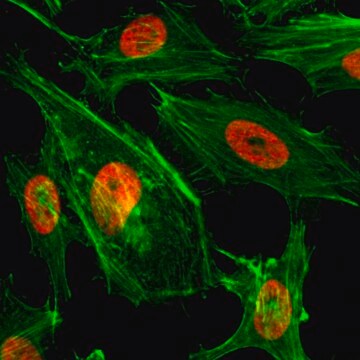07-710
Anti-SMC2/hCAP-E Antibody
serum, Upstate®
Autenticatiper visualizzare i prezzi riservati alla tua organizzazione & contrattuali
About This Item
Codice UNSPSC:
12352203
eCl@ss:
32160702
NACRES:
NA.41
Prodotti consigliati
Origine biologica
rabbit
Livello qualitativo
Forma dell’anticorpo
serum
Tipo di anticorpo
primary antibodies
Clone
polyclonal
Reattività contro le specie
human
Produttore/marchio commerciale
Upstate®
tecniche
western blot: suitable
N° accesso NCBI
N° accesso UniProt
Condizioni di spedizione
dry ice
modifica post-traduzionali bersaglio
unmodified
Informazioni sul gene
human ... SMC2(10592)
Descrizione generale
SMC2 and SMC4 from the active ATPase subunit of Condensin I and Condensin II complexes that regulate chromosome compaction.
Specificità
SMC2/hCAP-E
Immunogeno
KLH-conjugated, synthetic peptide corresponding to amino acids 1184-1197 (C-KSKAKPPKGAHVEV) of human SMC2/hCAP-E (Structural Maintenance of Chromosome 2/ Chromosome-Associated Protein E) with an N-terminal cysteine added for conjugation purposes.
Applicazioni
Anti-SMC2/hCAP-E Antibody is a high quality Rabbit Polyclonal Antibody for the detection of SMC2/hCAP-E & has been validated in WB.
Research Category
Epigenetics & Nuclear Function
Epigenetics & Nuclear Function
Research Sub Category
Cell Cycle, DNA Replication & Repair
Cell Cycle, DNA Replication & Repair
Qualità
Routinely evaluated by immunoblot.
Descrizione del bersaglio
137kDa
Stato fisico
Serum
Stoccaggio e stabilità
2 years at -20°C
Risultati analitici
Control
Positive Antigen Control: Catalog #12-309, Hela cell nuclear extract. Add an equal volume of Laemmli reducing sample buffer to 10 μL of extract and boil for 5 minutes to reduce the preparation. Load 20 μg of reduced extract per lane for minigels.
Positive Antigen Control: Catalog #12-309, Hela cell nuclear extract. Add an equal volume of Laemmli reducing sample buffer to 10 μL of extract and boil for 5 minutes to reduce the preparation. Load 20 μg of reduced extract per lane for minigels.
Note legali
UPSTATE is a registered trademark of Merck KGaA, Darmstadt, Germany
Esclusione di responsabilità
Unless otherwise stated in our catalog or other company documentation accompanying the product(s), our products are intended for research use only and are not to be used for any other purpose, which includes but is not limited to, unauthorized commercial uses, in vitro diagnostic uses, ex vivo or in vivo therapeutic uses or any type of consumption or application to humans or animals.
Not finding the right product?
Try our Motore di ricerca dei prodotti.
Codice della classe di stoccaggio
10 - Combustible liquids
Classe di pericolosità dell'acqua (WGK)
WGK 1
Certificati d'analisi (COA)
Cerca il Certificati d'analisi (COA) digitando il numero di lotto/batch corrispondente. I numeri di lotto o di batch sono stampati sull'etichetta dei prodotti dopo la parola ‘Lotto’ o ‘Batch’.
Possiedi già questo prodotto?
I documenti relativi ai prodotti acquistati recentemente sono disponibili nell’Archivio dei documenti.
Mingxuan Sun et al.
Chromosome research : an international journal on the molecular, supramolecular and evolutionary aspects of chromosome biology, 26(4), 277-295 (2018-08-26)
During cell division, chromosomes must be folded into their compact mitotic form to ensure their segregation. This process is thought to be largely controlled by the action of condensin SMC protein complexes on chromatin fibers. However, how condensins organize metaphase
Classification, subtype discovery, and prediction of outcome in pediatric acute lymphoblastic leukemia by gene expression profiling.
Yeoh, Eng-Juh, et al.
Cancer Cell, 1, 133-143 (2002)
Alexander Schleiffer et al.
Molecular cell, 11(3), 571-575 (2003-04-02)
We describe a superfamily of eukaryotic and prokaryotic proteins (kleisins) that includes ScpA, Scc1, Rec8, and Barren. Scc1 interacts with SMC proteins through N- and C-terminal domains to form a ring-like structure. Since these are the only domains conserved among
J A Schmiesing et al.
Molecular and cellular biology, 20(18), 6996-7006 (2000-08-25)
Structural maintenance of chromosomes (SMC) family proteins play critical roles in structural changes of chromosomes. Previously, we identified two human SMC family proteins, hCAP-C and hCAP-E, which form a heterodimeric complex (hCAP-C-hCAP-E) in the cell. Based on the sequence conservation
K Kimura et al.
The Journal of biological chemistry, 276(8), 5417-5420 (2001-01-04)
13S condensin is a five-subunit protein complex that plays a central role in mitotic chromosome condensation. The condensin complex was originally identified and purified from Xenopus egg extracts and shown to have an ATP-dependent positive supercoiling activity in vitro. We
Il team dei nostri ricercatori vanta grande esperienza in tutte le aree della ricerca quali Life Science, scienza dei materiali, sintesi chimica, cromatografia, discipline analitiche, ecc..
Contatta l'Assistenza Tecnica.






